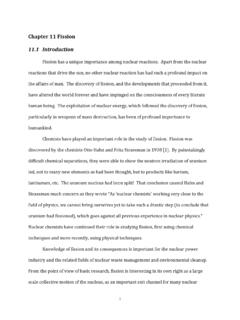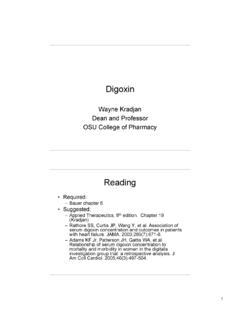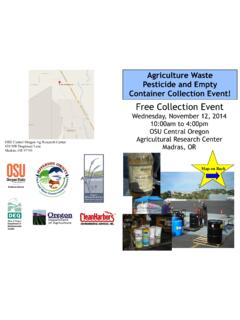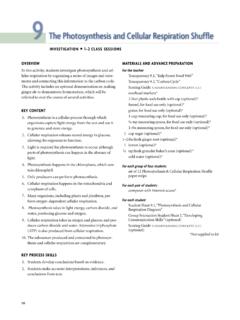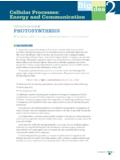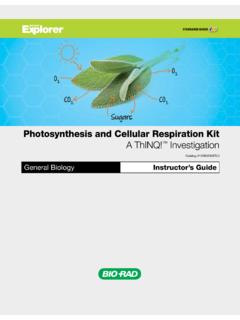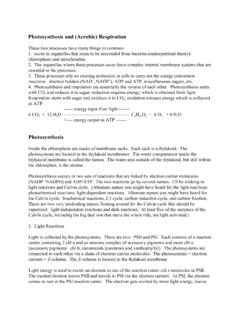Transcription of Photosynthesis, Respiration and Fermentation
1 Name_____ Section_____ Lab 5 photosynthesis , Respiration and Fermentation Plants are photosynthetic, which means that they produce their own food from atmospheric CO2 using light energy from the sun. This process is a complex series of steps involving the conversion of light energy into chemical energy, which is then used to synthesize sugars from carbon dioxide. The equation below summarizes the photosynthetic process Light + CO2 + H2O (CH2O)n + O2 sugar Once produced, the sugars can then be used for the Respiration that is required to support growth, maintenance and reproduction. Respiration is a process found in all organisms and, in the presence of oxygen, can be summarized by the equation (CH2O)n + O2 CO2 + H2O + energy photosynthesis and Respiration , on their surfaces, appear to be opposing reactions, but both have very different biochemical pathways and essential for a plant s metabolism.
2 photosynthesis takes place in the chloroplast to produce the sugars, starches and other carbohydrates for the plant s metabolic needs. cellular Respiration occurs in mitochondria where these carbohydrates are burned to produce chemical energy to do work at the cellular level. Animals also posses mitochondria in which cellular Respiration takes place, however, unlike plants, they must eat organic molecules for their cellular Respiration . Often their food source is plants. Some organisms respire in the absence of oxygen (anerobic Respiration ). Of particular importance to humans is the anaerobic breakdown of carbohydrates that lead to alcohol Fermentation .
3 The yeast, Saccharomyces cerevisae, (a unicellular fungus) is used in both bead making and alcohol brewing because of its capacity for alcohol Fermentation . In this process, sugars are broken down anaerobically in the cytosol to produce energy. Although Fermentation yields energy from breaking down sugars, it can do so only partially and is far less efficient than aerobic Respiration , which completely processes sugar molecules. Alcohol and CO2 are byproducts of Fermentation . The equation summarizing Fermentation is (CH2O)n C2H5OH + CO2 + energy Ethanol In today s lab we will be studying and monitoring photosynthesis , Respiration and Fermentation .
4 You will be setting up simple experiments to study the effects of light on photosynthesis in terrestrial and aquatic plants. You will also be measuring Respiration in developing seeds as well as identifying the relative levels of Respiration in the different structures of a seed. Finally you will be experimenting with Fermentation by monitoring the production of CO2 gas in actively growing yeast cultures. 1. photosynthesis Gas Exchange and Carbon Exchange Rates In this demonstration you will study the rate at which light affects CO2 exchange between plants and the atmosphere. Techniques in gas exchange monitor the concentration of CO2 in an air stream before and after passing over a metabolizing plant.
5 If a plant is photosynthesizing the CO2 in the air stream will be lower after being exposed to the plant; if it is respiring the CO2 concentration will be higher. The gas exchange apparatus monitors the rate of change in CO2 concentration and converts that into a carbon exchange rate (CER) on a leaf area basis ( moles CO2 sec-1 m-2). When CER is positive photosynthetic rates are greater than the Respiration rates; when the CER is negative then Respiration outpaces photosynthesis . Look at the gas exchange apparatus on display in lab today. Turn the lights on to see a response in gas exchange. Wait for a stable reading and record the value in the table below.
6 Lower the light intensity and note the change in CER. Turn the lights off and wait for a stable rate in CER. Record your values in the table below. Species CER High light CER Low light CER Dark photosynthesis and Respiration in Elodea In this exercise, you will use phenol red as an indicator to show whether CO2 is being consumed or produced. In the presence of light, plants photosynthesize and at the same time they are also undergoing cell Respiration . To demonstrate this, we will determine whether CO2 is consumed or produced as Elodea is placed in either a light or dark environment.
7 The change in CO2 will be detected by the pH indicator phenol red. In a closed system, actively photosynthesizing plants will be consuming more CO2 than they release from Respiration resulting in a drawdown of CO2 gas. Under dark conditions, plants will only release CO2 resulting in a build up in CO2. The pH of aquatic environments is greatly influenced by CO2 concentrations; at high CO2 concentrations the water becomes acidic and at low CO2 water becomes more basic. Phenol red is yellow under acidic conditions (high CO2 concentration), red under basic or alkaline conditions (low CO2 ion concentration) and orange under neutral conditions.
8 A change in CO2 resulting from photosynthesis or Respiration will result in a proportional change in pH and can be qualitatively monitored with color changes in a phenol red solution. Procedure: Obtain a solution of phenol red (about 100 ml). The solution should be at a neutral pH (~ ) and an orange color. Transfer the solution into 4 test tubes (they should be filled about 2/3 full with your orange solution). Place a cut piece of elodea (cut end up) into two of the four tubes. The other two test tubes will not have elodea and will serve as controls. One control will be placed in the light, and one set in the dark (see data table).
9 All test tubes should be covered with parafilm to minimize reactions with the air. Record the colors of the solutions in the test tubes after 1-2 hours. Color (time) Elodea dark Elodea light just phenol red dark (control) just Phenol red light (control) Starting ( ) Ending ( ) Explain any color changes noted in the test tubes. Why were the two controls included? 2. Respiration In these exercises you will be studying the rate of Respiration in germinating seeds or other plant parts ( potato tissue). Respiration is the sum of three different metabolic processes: glycolysis, the Krebs cycle and the electron transport system.
10 Glycolysis and the Krebs cycle together methodically breakdown carbohydrates to release the energy stored in their bonds (CO2 release occurs during the Krebs cycle). These breakdown steps release electrons which are run through an electron transport system to drive the production of cellular energy molecules (ATP). In today s lab we will be looking at evidence in support of O2 consumption during Respiration and electron transport activity. Electron Transport during Respiration You will use a weak solution of a tetrazolium salt as an indicator of electron transport activity associated with cellular Respiration .
